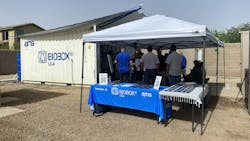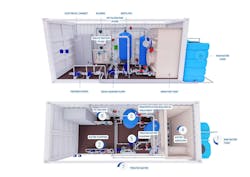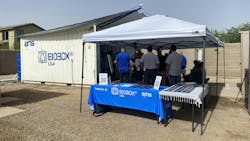Innovating water quality in Arizona: Gilbert's first-of-its-kind biological nitrate removal system
Arizona experiences persistent nitrate contamination in groundwater. Both past and present agricultural practices contribute to this water quality concern, leading to nitrate exceeding the United States Environmental Protection Agency (U.S.EPA) maximum contaminant level (MCL) of 10 parts-per-million (ppm) in several areas across the state.
Once known as the “Hay Capital of the World”, Gilbert, Arizona, is the home to more than 275,000 residents. Its water supply comes from a diverse water portfolio that includes the Salt River Project (Salt River and Verde River Basins) and the Central Arizona Project (Colorado River). The town’s public works department operates and maintains a network of two surface water treatment plants, 16 water storage reservoirs, and 21 groundwater wells. Several of these wells are impacted by nitrate contamination, with two exceeding the EPA MCL. One of these wells is blended with surface water to reduce nitrate levels before distribution; however, blending was not feasible at the other remote location (Well #22), which has a flow rate of 650 gallons-per-minute (gpm) and high nitrate levels of 26 ppm.
Traditional nitrate treatment options, including reverse osmosis (RO) and ion exchange (IX), were considered; however, these technologies had a large footprint, proved to be energy-intensive and produced an undesirable waste stream. Given these limitations, the town sought an innovative, space-saving, energy-efficient, and sustainable treatment option to address nitrate removal in their groundwater.
“Biological denitrification has been proven as a viable nitrate removal solution in wastewater applications for decades,” said Rebecca Hamel, MPA, Water Manager for the Town of Gilbert Public Works Department. “While the technology’s application in drinking water is commonplace in Europe, there are a limited number of biological denitrification systems in practice for U.S. potable water applications. As an emerging drinking water technology, the reactive mechanics of biological denitrification has tremendous potential to reduce nitrate contamination.”
“Gilbert has never shied away from innovation; we take pride in our “city of the future” initiatives. This partnership with BIOBOX (from Zaragoza, Spain) to bring their technology to Arizona and host the first U.S. demonstration was an incredible opportunity,” said Hamel.
The key advantage of biological treatment is its ability to remove nitrates efficiently with very little energy under anaerobic conditions. In addition, there is no disposal of a brine solution, which is used during the regeneration process of the resin used in IX and the waste product of RO.
The BIOBOX system transforms nitrates into harmless nitrogen gas, ensuring over 95% nitrate removal while maintaining low water consumption and producing minimal waste through a safe and harmless NSF 60/61 Standard approved biomaterial (certified Food Grade, Group 1). The technology also features online condition monitoring, which provides real-time health data for the onboard water quality instruments. This unique approach allows for remote process control and optimization.
From Theory to Reality: Bringing Biological Nitrate Removal to Life
In 2024, a 20-foot containerized treatment plant (Figure 1) equipped with nitrogen removal, disinfection, and filtration systems was installed at Well #22. The Gilbert Public Works Department operated the plant for several months to assess the biological denitrification technology. While in operation, various parameters, including acetic acid, phosphates, sodium hypochlorite residual, Langelier Saturation Index (LSI), Chemical Oxygen Demand (COD), and Oxidation-Reduction Potential (ORP) were monitored using online instrumentation and lab testing. These measurements ensured the biological treatment did not compromise overall water quality, achieving consistent disinfection and corrosion control.
Prior to the biofilter stage, ultraviolet (UV) disinfection was applied since the microbial community in the treatment process may be sensitive to outside organisms. The incoming water needed to pass through UV for disinfection, and not a chemical disinfectant, because the process does not impart a residual disinfectant that could impact the biology in the biofilter. Immediately after the biofilter, the water passed through a second UV disinfection unit to remove any residual microbiological presence that might persist. The UV disinfection process was monitored continuously with two online ORP instruments.
Following the biological process, the water was disinfected with sodium hypochlorite to remove any bacteria from the biofilter stage and to help increase the ORP. After UV disinfection and sodium hypochlorite dosing, a COD sensor was installed downstream of the aeration tank to help the operators determine the presence of organic contaminants that might impact the effectiveness of UV treatment. The COD sensor was placed after all the treatment processes because it was essential to know the COD in the treated water, not in any intermediate point. Aeration occurred continuously during the process. The primary purpose of the aeration was to increase the dissolved oxygen (DO) in the treated water. During denitrification in the biofilter, DO levels in the source water were substantially decreased, and aeration helped to restore the levels. After aeration, much of the original disinfectant dose was used entirely. Therefore, a second dose of sodium hypochlorite was added to help supply a free chlorine residual to the finished water.
From Contaminated to Clean: Measuring the Impact of Biological Treatment
The treatment plant demonstrated consistent and significant nitrate reductions from 26 ppm in well water influent to approximately 2ppm (non-detect levels) in the final, finish water (Figure 2). The biology required less than 40 hours to get the effluent levels below 10 ppm after a three-week shutdown between March and April 2024 and approximately eight hours after a one-week shutdown in June 2024.
The plant demonstrated compliance with the Town’s and County’s requirements for biological nitrate removal, turbidity, and other parameters. The system demonstrated remarkable success in consistently reducing turbidity levels to below 0.3 nephelometric turbidity units (ntu) using a two-stage filtration system in conjunction with coagulant addition (Figure 3). Online turbidity meters, calibrated and programmed to record turbidity every 15 minutes, were installed and operated before and after the filter assemblies.
With successful results from the demonstration program, the Town of Gilbert applied for an Approval of Proposed Plan (AOPP) with the Maricopa County Environmental Services Department (MCESD), permit application #2023070. At the time of publication, approval is still pending.
Beyond Arizona: A Blueprint for Nationwide Nitrate Removal Solutions
As the host of the inaugural demonstration of the BIOBOX biological denitrification system in the U.S. the Town of Gilbert held a series of open house events in June 2024 (Figure 4). Municipalities, consulting engineers, and other stakeholders seeking sustainable solutions to the persistent issue of nitrate removal from groundwater supplies were invited. Participants had the opportunity to see a live demonstration of the technology. Representatives from the Town of Gilbert, BIOBOX USA, and AMS were present to answer questions and provide valuable insights.
“This demonstration project highlights Gilbert's commitment to collaborative innovation and continued environmental stewardship,” said Hamel. “This project offers a promising blueprint for other communities across the U.S. facing similar challenges, and takes a large step for the industry towards the demystification of biological denitrification for potable water applications.”
The Town of Gilbert wishes to thank their community, BIOBOX, AMS, and MCESD, for their support during this demonstration project.
About the Author

Jeff Bower
Jeff Bower is a registered civil engineer with the Town of Gilbert’s Public Works Department. As a consultant, he designed several hundred water and wastewater system projects throughout Arizona and Florida and now develops the Town of Gilbert’s computer and pilot-scale models. Jeff holds an M.S. in Civil Engineering and B.S. in Aerospace Engineering from the University of Florida.




